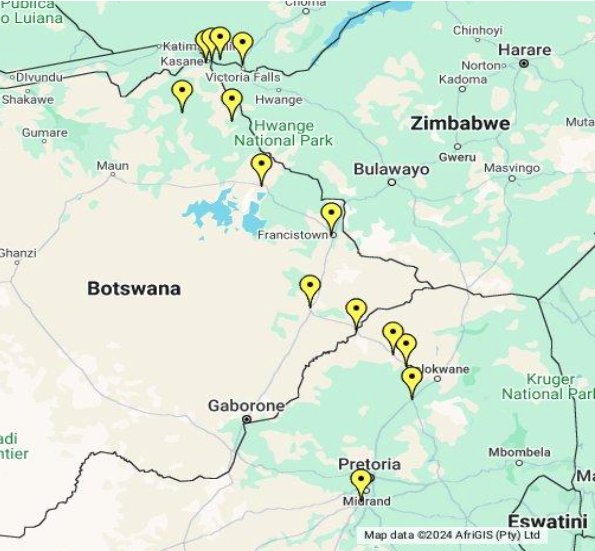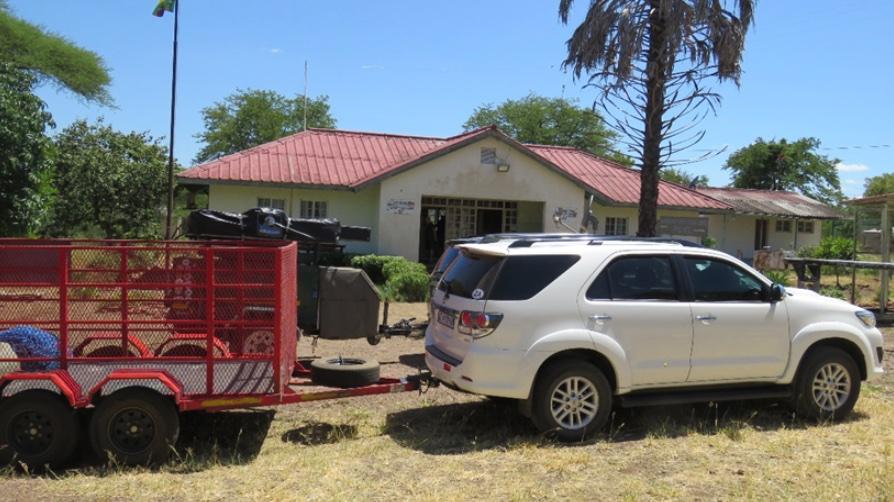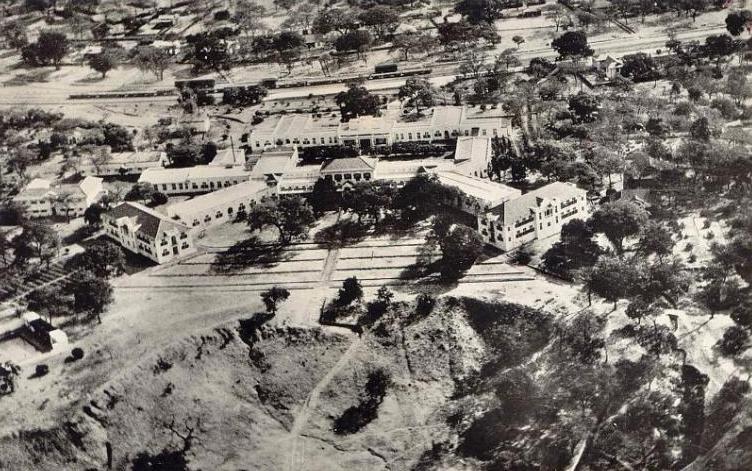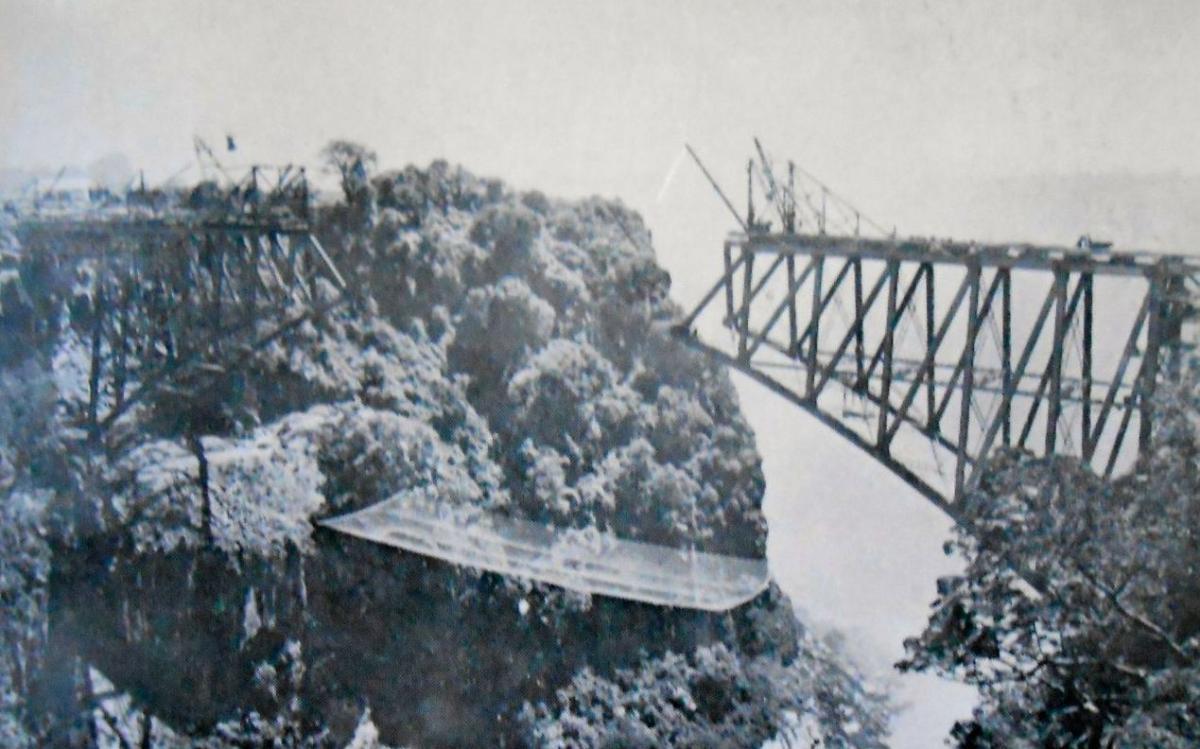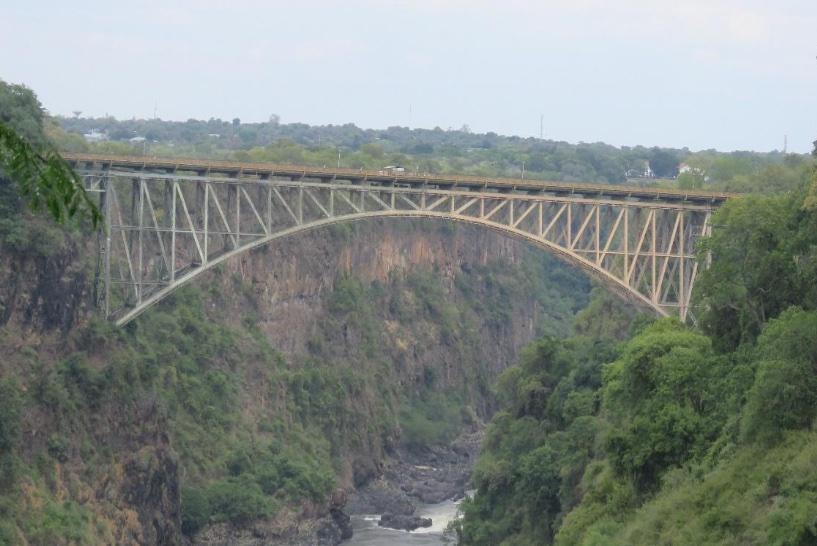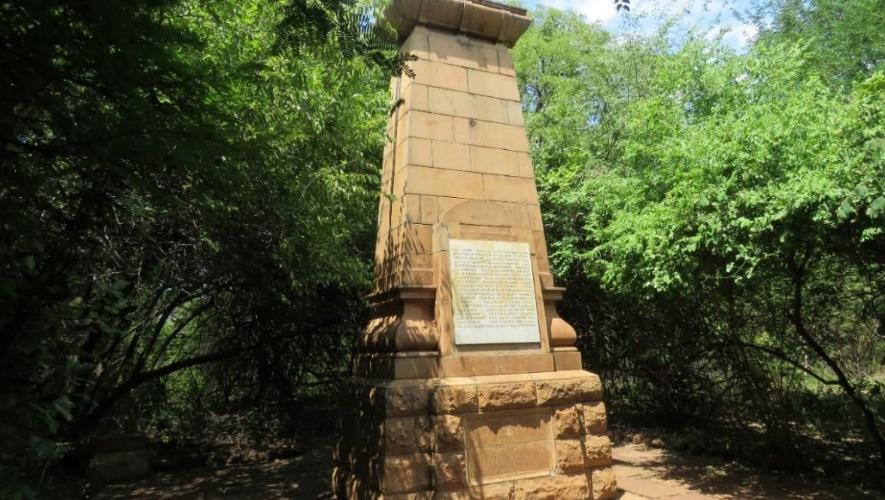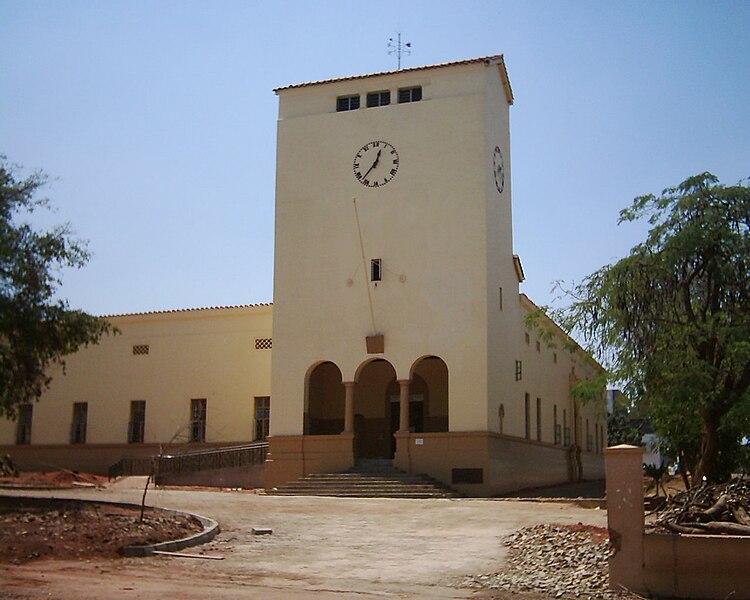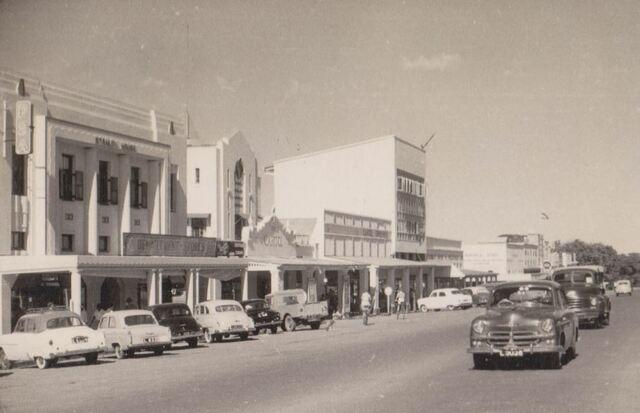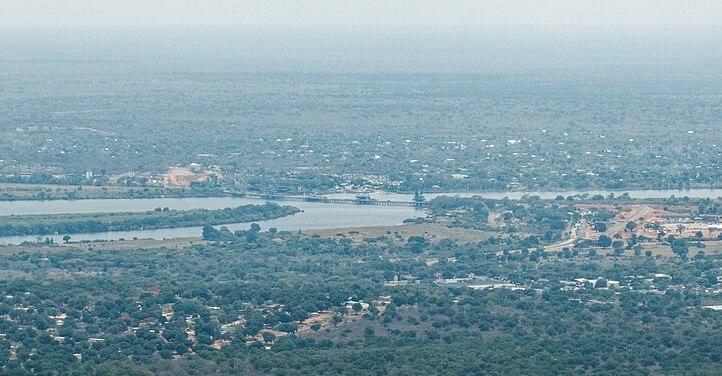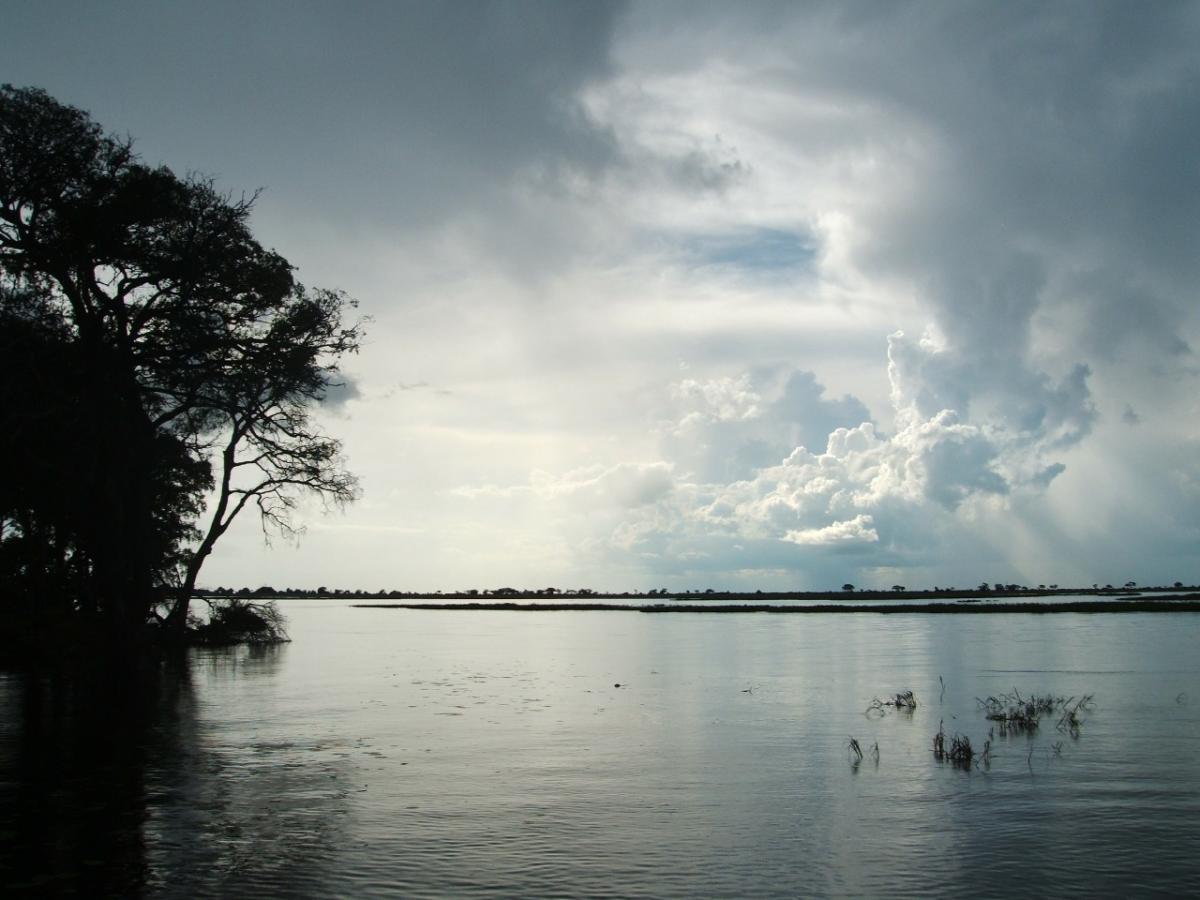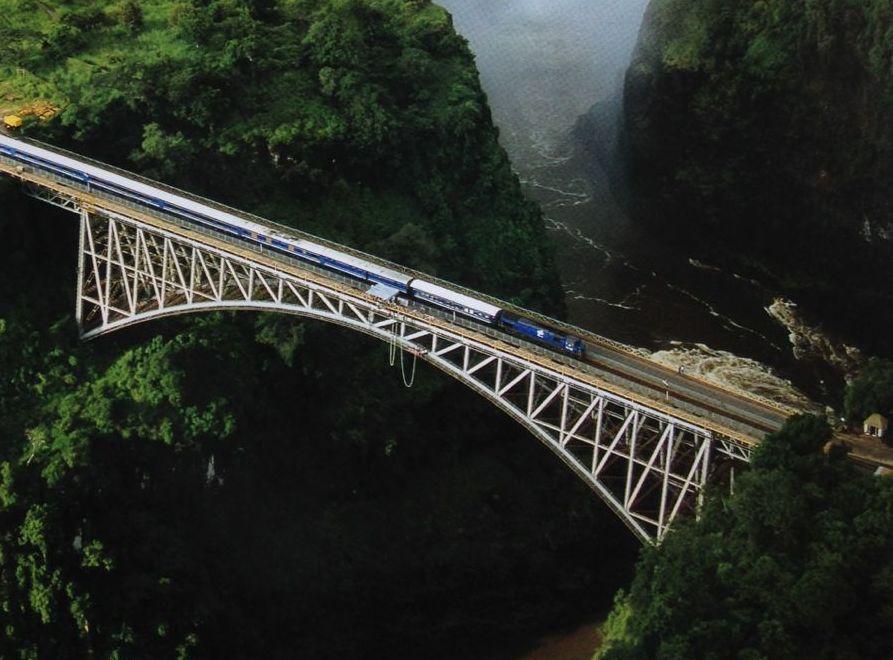
Disclaimer: Any views expressed by individuals and organisations are their own and do not in any way represent the views of The Heritage Portal. If you find any mistakes or historical inaccuracies, please contact the editor.
A recent road trip to Zambia, to assist my friends in transporting the zooarchaeology artefacts of their son’s girlfriend (a PhD candidate) from the Livingstone Museum to South Africa for further scientific analyses, gave Lorraine and I the opportunity to see something of the countries to our north.
Our route to Livingstone and back to Johannesburg
On our first night we stayed over at Big Fig Oasis Camp, a few kilometres before Grobler Bridge and the Martin’s Drift Border Post to Botswana. While the other couple and we were comfortably ensconced in airconditioned chalets, their son (Christian), braved the tent atop the camping trailer. He certainly drew the short straw as he also had to prove his excellent braaiing talents on several occasions.
Like all overland trips, ours had some moments of vexation. Firstly, my friend’s SUV suffered a break down near Modimolle, causing delay, while Christian’s Pajero was brought up from Johannesburg as replacement vehicle. The following morning at the Martin’s Drift Border Post, a burst water pipe water caused a temporary closure of said post. Hobson’s choice: wait for the water to be restored or detour to the Stockpoort Border Post (‘Parr’s Halt’ in Botswana) some 80 kilometres to the south-west. Unsure of the duration of the delay, we opted for the latter, and what a swift crossing at this little border post we enjoyed!
At the Martin’s Drift Border Post into Botswana, trying to determine when the border post would reopen (SJ de Klerk)
The 780 km long drive from Martin’s Drift via Stockpoort to Pandamatenga in far north-eastern Botswana, where we overnighted at Panda Camp, was a full day affair. Our route took us through Mahalapye, Phalapye, Francistown and Nata, before reaching our destination. We only stopped at Francistown for a quick pizza lunch and to refuel before pushing on. While many stretches of this road were excellent, some ranged from average to poor. This, with speed limits abruptly reducing from 120, to 60 and even 30 kms per hour, combined with the presence of roadside cattle and goats, and the possibility of game unexpectedly crossing the road, ensured a much slower and longer journey, than we anticipated. The last part of this journey was completed after sunset, not an ideal experience, for the reasons just provided.
At Panda Camp, we enjoyed a late dinner while Sundowner moths (Sphingomorpha chloe) occasionally disturbed our imbibing liquid refreshments from the Boland and Scotland, respectively.
Only because of the long drive the previous day, we departed Panda Camp well after breakfast.
The Zimbabwean Border Post at Pandamatenga where we crossed speedily. Christian’s Pajero on the far side towing the camping trailer and my trusty Fortuner lugging the box trailer for the anticipated zooarchaeology artefacts of Evin Grody. (SJ de Klerk)
At the Pandamatenga border crossing from Botswana into Zimbabwe, we were the only two vehicles entering the Hwange Wilderness Area, since the morning of the previous day.
Although we quickly crossed at this border post, it was well into mid-morning when we travelled through the Hwange Wilderness Area and thus sighted no game. The road, although a decent gravel one, nevertheless contained several heavily corrugated sections. Emerging on the A8, the main tarred, but potholed road between Hwange and Victoria Falls, we proceeded slowly to our next overnight stop at Victoria Falls, the excellent Shongwe Oasis Boutique Hotel. The Pajero hauling the offroad camper drove ahead to alert me, towing a wider and less rugged trailer, of any looming potholes. But notwithstanding this, as we subsequently discovered in Livingstone, one of the axles of the trailer had come loose through the impact of driving through plenty of potholes, which necessitated repairs.
At the hotel, we ascended the lookout tower for a distant sunset view of the mist hovering over Victoria Falls, before enjoying a pleasant dinner. Next morning, in preparation for our somewhat dreaded border crossing into Zambia, we all first stopped for morning tea at the Victoria Falls Hotel. This grand old lady with its lovely view of the historic bridge across the Zambesi Gorge, remains the ultimate Vic Falls holiday destination in Zimbabwe.
Well-known Bulawayo architect Frank Scott completed the final designs of the Victoria Falls Hotel in April 1912, but construction only commenced in 1914, with the hotel opening on 1 April 1917.
Although the hotel has been added to over the decades, it initially offered twenty-four bedrooms, two suites and five public rooms. The furniture was imported from Waring & Gallow in London, although I did see several sturdy chairs that appeared to have been made locally from Rhodesian teak.
The swinging 20’s brought more visitors to both the Falls and the Hotel, and soon additional rooms and facilities were required.
In 1927, JR Hobson, the Railway architect designed the enlargement of the hotel. The original plan was simply to create a 2nd storey over the existing building, but eventually two double-storey ‘hammerheads’ were added at the end of the bedroom wings. A summer parlour was also added over the lounge, and open in the front. It provided useful lounge accommodation for the greater number of guests and a magnificent view down the Gorge to the Bridge.
Old postcard of the Victoria Falls Hotel. We enjoyed mid-morning tea here in preparation for the border crossing.
Cecil John Rhodes insisted that the bridge should be placed near the falls to ‘have the spray of the water over the carriages.’
Victoria Falls Bridge under construction (George Pauling)
The 198m steel bridge was designed by George Andrew Hobson of the English firm Sir Douglas Fox and Partners. The sections were manufactured and assembled at the Cleveland Bridge and Engineering factory yard in Darlington, UK, prior to shipment to Africa. Its main arch spans 156m and is 128m above the river surface. The bridge was officially opened on 12 September 1905, by Professor George Darwin, son of the renowned naturalist Charles Darwin.
Close up view from the Victoria Falls Hotel of the iconic steel road and railway bridge across the Gorge (SJ de Klerk)
Unlike our previous border crossings, the one from Victoria Falls to Livingstone proved more challenging. The departure from Zimbabwe was quick, but on the Zambian side proceedings slowed down considerably. Fortunately, the Zambian Border Post was airconditioned, a blessing in the intense heat. Having heard how border helpers or touts, rather disconcertingly tended to periodically disappear, and then unexpectedly reappear with one’s passport, we were initially reluctant to use the services of one. But for a fee of USD20, ours undoubtedly expedited our crossing into Zambia. After about two and a half hours we were authorized to proceed, somewhat poorer for road, emissions and third-party taxes and other fees, plus of course a tip to the obligatory car guard, mostly paid for in US Dollars or exchanged into Kwachas by the local money changers at very favourable rates to themselves.
Our accommodation at the Munga Eco Lodge at Livingstone was reasonable, but we dearly missed the air conditioning we had enjoyed at our previous lodgings. At least the chalets were thatched, but the ceiling fan failed to disperse the hot air above the mosquito nets.
After a light breakfast we were off to view Mosi-oa-tunya, ‘the smoke that thunders,’ also known as the Victoria Falls. The Falls are 1.7kms wide, with a maximum height of 108m and a maximum water-flow of 500 million litres/minute. Following a short stroll next to the placid Zambesi River above the Falls, we soon ventured across the little Knife Edge pedestrian bridge, to the island of the same name. On Knife Edge Bridge built in 1968, the tumbling water mass over the Eastern Cataract was a mere 110m distant. In seconds we were drenched by the rising spray, a welcome relief from the heat. At the end of February, when we were there, the Falls must have been close to their maximum water flow volume.
Tourism authorities advocate the best time of the year to view the falls is between May and August, when the weather is perfect and there is plenty of water in the Zambezi, but the spray is not excessive.
Upon our return from the Knife Edge Bridge and Island, we paid our respects at the nearby ‘Northern Rhodesian Great War Memorial’ erected to ‘The Memory of Northern Rhodesians who gave their lives for the Empire in the Great War 1914 – 1918’.
The Cenotaph to the casualties of the Great War at Victoria Falls (SJ de Klerk)
The Great War Memorial was rededicated as a Cenotaph in November 2017. Interestingly, the names of several South Africans are inscribed on the inset marble panels. I subsequently discovered that the sandstone panels of this Memorial were supplied by the Pasipas Quarry, one of two great quarries, that supplied building material for many of Bulawayo’s fine early buildings.
After our exertions at the Falls, on Christian’s recommendation, we retired to a casual but tasty lunch at Kubu Café, washed down with the excellent Zambian Lager, Mosi.
The next morning, we visited the Livingstone Museum where Evin Grody had recently completed some of her zooarchaeological research. Now it was a matter of loading her 22 large plastic boxes of artefacts onto the box trailer we had brought along for this very purpose. Then their long road journey back to South Africa, and specifically to the University of Pretoria.
The Clock Tower of the Livingstone Museum. The clocks were presented by the pioneers Harry and Elie Susman in 1951 to commemorate their entry into Northern Rhodesia, fifty years prior. (Wikipedia)
Evin had kindly arranged permission for me to take photos inside the Museum and hopefully at some future date I might be able to review the interesting collections curated there.
I purchased an informative little booklet by Rob Burrett and Clare Mateke, entitled Shongwe – The Rich Heritage of Livingstone and Victoria Falls.
Guided by this booklet, Lorraine and I drove around Livingstone viewing some of its historical and interesting buildings, such as Stanley House, a classic art deco building dating from 1928, as the upmarket store of Harry Stossen. It has first floor doric columns exhibiting a distinct Egyptian element influenced by the 1922 discovery of the tomb of King Tutankhamun.
The adjacent and equally attractive Capitol Theatre was erected by the Grill family in 1931. Designed in the American Spanish Colonial Revival style, there are elements of art deco in its simplified, angular forms. The chevron pattern symbolises the Zambezi River and echoes the old Northern Rhodesia coat-of-arms. The theatre could seat 500 people and had a bar, tea-room and dining room and was the place to be seen in the 1950’s.
Old photo of the Capitol Theatre (Cinema Treasures)
ArchSoc stalwart Keith MacMullen, an architect by profession, speculated that The Capitol Theatre might have been designed by an American architect. Apparently, the cinema companies that erected these early theatres in Africa, employed American architects from Hollywood to design them. In support of this supposition, Rob Burrett, the Zimbabwean heritage specialist confirmed that there are no buildings in Bulawayo that echo the architectural styles of these two buildings.
Livingstone must have had a sizeable Jewish population at one time as it also boasted a synagogue, now used by the Church of Christ. The foundation stone was laid in 1928 by Elie Susman whose business empire stretched across much of what is now southern and western Zambia. However, as the Livingstone Jewish community gradually dispersed, the synagogue closed its doors in 1972, and the building sold. The adjacent old Jewish Hall became the Elaine Bittrell Christian School.
That evening we all shared a delicious Indian meal on the covered patio of the Golden Leaf Restaurant in Mosi-oa-tunya Road, in Livingstone.
After a stay of three nights at Mangu Eco Lodge, we departed Zambia for Botswana across the very impressive Kazungula Bridge, that links these two countries across the Zambezi River.
Kazungula Bridge (Wikipedia)
This 923 m long and curved road and railway bridge was officially opened on 10 May 2021, by the Presidents of Botswana and Zambia.
While it was a pleasure to cross the mighty Zambezi River over this bridge, I still felt a tinge of regret that we would no longer be able to cross it by pontoon boat, like the intrepid travellers of old.
Once across, we arrived at the modern Botswana Border Post offices. While here there were no touts to bother us, it still took a while to clear ourselves, vehicles, trailers and respective loads through customs.
We were rushing to reach our overnight accommodation, the Senyati Safari Camp, as we were keen to do a cruise on the Chobe River. Quickly unpacking and unhooking the two trailers, we sped back to Kasane where my friend Arno negotiated a lower rate for a shorter cruise on a smaller boat, as we had arrived too late for one of the larger boat cruises.
Chobe River (Vicki Ball)
The Chobe is a tributary of the great Zambezi River, and home to the greatest concentration of elephants in Africa. It has its source in the Highlands of Angola, although sections between its source and confluence with the Zambezi River, are often dry.
Apparently, much of the water in the Chobe River in the National Park is backwash from the Zambezi River.
Our companions who are keen ‘twitchers’ were enthralled by the bird and wildlife - elephants, hippos, buffalos, giraffe, crocodiles, and many bird species.
That evening as we returned to our accommodation at the Senyati Safari Camp for a braai, we were again treated to scores of elephants and buffaloes either quietly passing through or grazing and drinking at the waterhole in front of our chalet.
Sadly, Johannesburg beckoned. But first we overnighted for two nights at the Nata Lodge in comfortable tented accommodation sheltered by abundant trees.
The following day Arno and family departed for the Nata bird sanctuary. If I recall correctly, Evin identified some forty bird species at this sanctuary. Lorraine and I opted for a more sedentary day, reading and relaxing by the pool.
The day thereafter, we arrived late in the afternoon at Martin’s Drift border post, but this time our crossing was not delayed by any unforeseen event.
On our last night we again overnighted at the Big Fig Oasis Camp, arriving in Johannesburg at about lunch time with the artefacts safely in tow.
Notwithstanding initial nervousness related to border crossings and towing a large box trailer over some rough roads, we had a wonderful trip with a totally different experience to merely flying into Vic Falls or Livingstone, seeing the Falls and staying at a fancy hotel before a seamless departure.
Our passenger on the return journey was Evin Grody, a PhD candidate with the Department of Anthropology at Columbia University in New York. Her dissertation research combines existing museum collections with newly excavated faunal material to examine human-animal relationships over the last 2,000 years (roughly the ‘Iron Age’). This project focuses on Zambian sites and connects analyses of procurement and processing with new theoretical frameworks to reconsider the skill, technology, and responsiveness woven into animal use strategies. It seeks to reassess our understanding of human-animal relationships in this period, and their broader significance in the context of the economic, craft, social, and political changes in southern and south-central Africa over the last two millennia.
Main image: Blue Train moving across Victoria Falls Bridge (Gus Silber)
SJ de Klerk is a retired human resources practitioner. Since retirement he has been writing articles on various aspects of South African history for The Heritage Portal. He is Chair of the Northern Branch of the Archaeological Society.
Sources
- Burrett R. & Mateke C. Shongwe – The Rich Heritage of Livingstone and Victoria Falls. Khami Press. 2018.
- Creewel J. A History of the Victoria Falls Hotel – 90 Glorious Years. HarperCollins Publishers (Zimbabwe). 1994.
Comments will load below. If for any reason none appear click here for some troubleshooting tips. If you would like to post a comment and need instructions click here.

